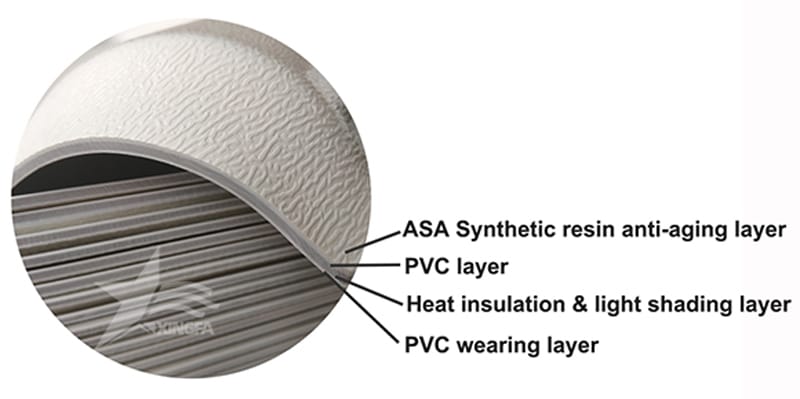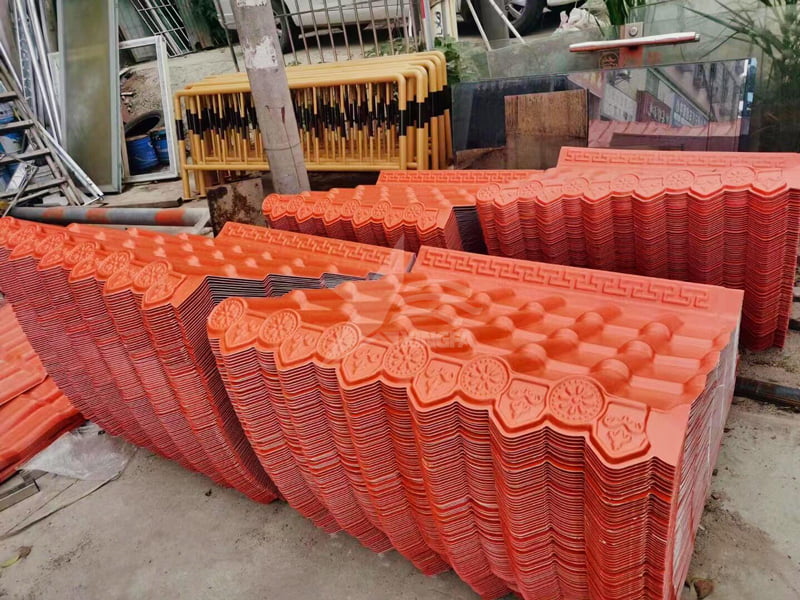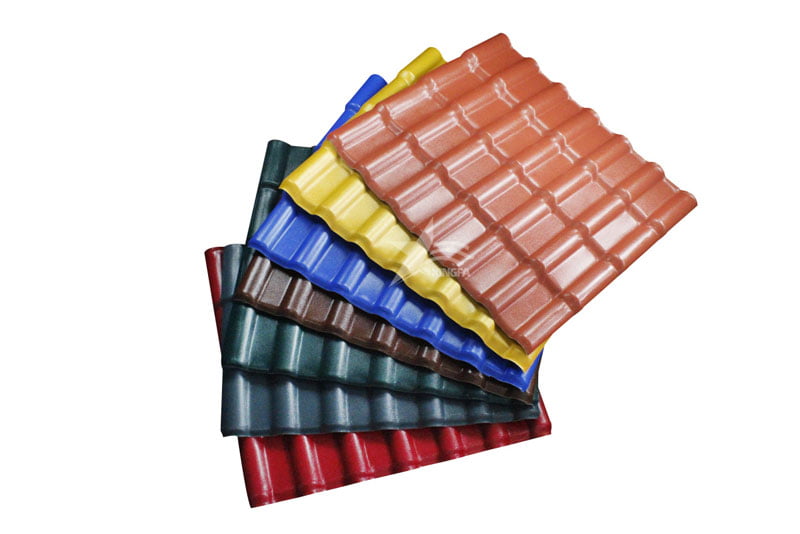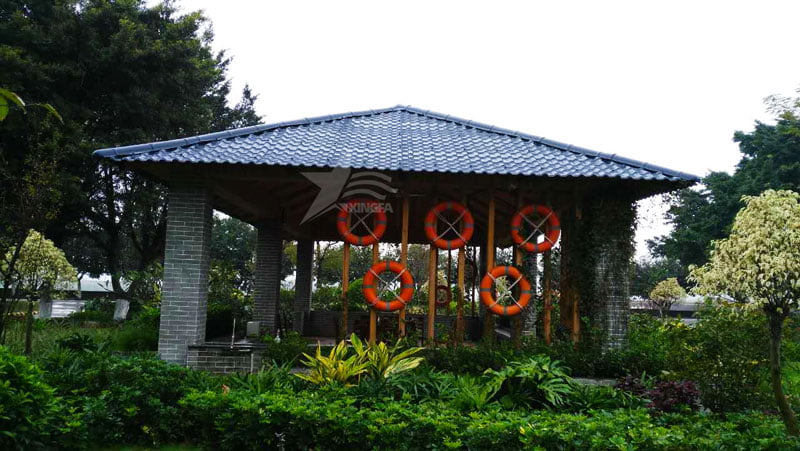In recent years, resin tiles have rapidly emerged as a standout in the roofing tile industry, garnering significant market attention. Beyond their striking appearance, it is their exceptional performance that has become a crucial factor for users. Today, let’s delve into the unique features of the four-layer structure of resin tiles and explore why they are so highly favored.
The First Layer: ASA Weather-Resistant Layer
The outermost layer of the resin tile is crafted from ASA (Acrylonitrile Styrene Acrylate), a material known for its excellent weather resistance. This layer serves as the first line of defense against the elements, providing superior protection against ultraviolet rays, extreme temperatures, and other harsh environmental factors. By effectively shielding the tile from these natural adversities, the ASA layer significantly extends the lifespan of the resin tile, ensuring long-lasting durability and color retention.
ASA’s unique properties make it particularly adept at resisting degradation caused by prolonged exposure to sunlight and UV radiation. Unlike traditional roofing materials that may fade, crack, or deteriorate over time, resin tiles with an ASA weather-resistant layer maintain their vibrant color and structural integrity for years. This not only enhances the aesthetic appeal of buildings but also reduces maintenance costs, making them a cost-effective choice for homeowners and builders alike.
The Second Layer: Impact-Resistant Layer
Beneath the ASA layer lies the impact-resistant layer, the second crucial barrier of the resin tile. This layer is engineered to withstand severe weather conditions, such as hailstorms and high winds, which can cause significant damage to conventional roofing materials. By effectively absorbing and dispersing impact forces, the impact-resistant layer protects the resin tile from cracks, dents, and other forms of damage, ensuring the integrity and safety of the roofing structure.
The impact resistance of this layer is particularly beneficial in regions prone to extreme weather events. Homeowners can rest assured that their roofs will remain intact and functional even in the face of severe weather, reducing the need for frequent repairs or replacements. Additionally, the enhanced durability provided by the impact-resistant layer makes resin tiles an ideal choice for buildings located in coastal areas, where saltwater corrosion and strong winds can pose significant challenges to roofing materials.
The Third Layer: Insulating Layer
The third layer of the resin tile is the insulating layer, which plays a pivotal role in thermal regulation. During hot weather, this layer minimizes the amount of heat absorbed by the tile, thereby improving the overall insulation of the roof. By reducing heat transfer into the building, the insulating layer helps maintain a comfortable indoor environment, lowering the reliance on air conditioning and subsequently reducing energy consumption.
The insulating properties of resin tiles make them an environmentally friendly option for modern buildings. By enhancing energy efficiency, they contribute to reduced greenhouse gas emissions and lower energy bills for homeowners. This is particularly important in today’s world, where sustainable building practices and energy conservation are becoming increasingly prioritized. Furthermore, the insulating layer also helps in noise reduction, providing a quieter indoor environment by dampening external sounds such as rain or hail.
The Fourth Layer: Wear-Resistant Layer
The innermost layer of the resin tile is the wear-resistant layer, designed to ensure the tile’s surface remains smooth and durable. This layer effectively resists the daily wear and tear caused by environmental factors such as wind, rain, and plant growth. By maintaining the integrity of the tile surface, the wear-resistant layer enhances the overall durability and longevity of the resin tile, ensuring it remains functional and visually appealing for an extended period.
The wear-resistant layer also plays a crucial role in preventing the growth of moss and algae, which can be common issues with traditional roofing materials. By providing a smooth, non-porous surface, it inhibits the accumulation of moisture and debris that can lead to the growth of these organisms. This not only enhances the aesthetic appeal of the roof but also reduces the maintenance required to keep it in optimal condition.
Comprehensive Protection and Aesthetic Appeal
Overall, the advanced four-layer structure of resin tiles offers comprehensive protection for roofs, making them stand out in the market. By combining weather resistance, impact resistance, insulation, and wear resistance, resin tiles provide a holistic solution that addresses the various challenges faced by traditional roofing materials. Homeowners and builders who choose resin tiles not only benefit from their unique and attractive appearance but also enjoy the advantages of long-lasting durability and high performance.
The aesthetic versatility of resin tiles is another key factor contributing to their popularity. Available in a wide range of colors and styles, they can complement various architectural designs, from modern minimalist homes to traditional rustic cottages. This versatility allows builders and homeowners to achieve their desired aesthetic while ensuring the functional benefits of advanced roofing technology.
Applications in Modern Construction
Resin tiles are widely used in various construction projects, from residential homes to commercial buildings and public structures. Their ability to withstand extreme weather conditions and their low maintenance requirements make them a preferred choice for projects in diverse environments. For instance, in coastal areas where saltwater and strong winds can accelerate the deterioration of conventional roofing materials, resin tiles provide a durable and reliable alternative.
In addition to their practical benefits, resin tiles also contribute to the sustainability of modern construction. By enhancing energy efficiency and reducing the need for frequent repairs or replacements, they help minimize the environmental impact of buildings. This aligns with the growing emphasis on sustainable building practices and the use of eco-friendly materials in the construction industry.
Innovation and Future Prospects
The continued innovation in the field of resin tiles is driving their adoption in the roofing industry. Advances in material science and manufacturing processes are leading to the development of even more resilient and efficient resin tiles. For example, the integration of advanced polymers and nanotechnology is enhancing the performance characteristics of resin tiles, making them more resistant to environmental stressors and extending their lifespan further.
As the demand for high-performance roofing materials continues to grow, resin tiles are poised to play a significant role in the future of construction. Their ability to combine aesthetic appeal with functional benefits makes them an attractive option for a wide range of applications. Moreover, ongoing research and development efforts are likely to result in new innovations that further enhance the capabilities of resin tiles, ensuring they remain at the forefront of roofing technology.
Conclusion
In conclusion, the four-layer structure of resin tiles represents a significant advancement in roofing technology. By providing comprehensive protection against environmental factors and enhancing the aesthetic appeal of buildings, resin tiles have become a highly favored choice in the market. The combination of an ASA weather-resistant layer, an impact-resistant layer, an insulating layer, and a wear-resistant layer ensures that resin tiles offer unparalleled performance and durability.
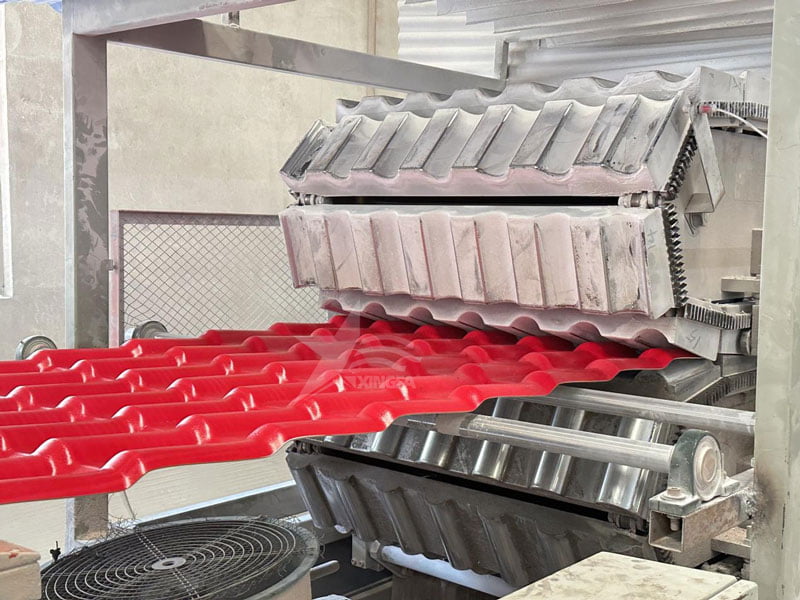
As the construction industry continues to evolve, the demand for innovative and sustainable roofing materials is set to increase. Resin tiles, with their advanced four-layer structure and numerous benefits, are well-positioned to meet this demand and play a crucial role in shaping the future of roofing. Whether for residential, commercial, or public buildings, resin tiles offer a reliable, cost-effective, and aesthetically pleasing solution that stands the test of time.

